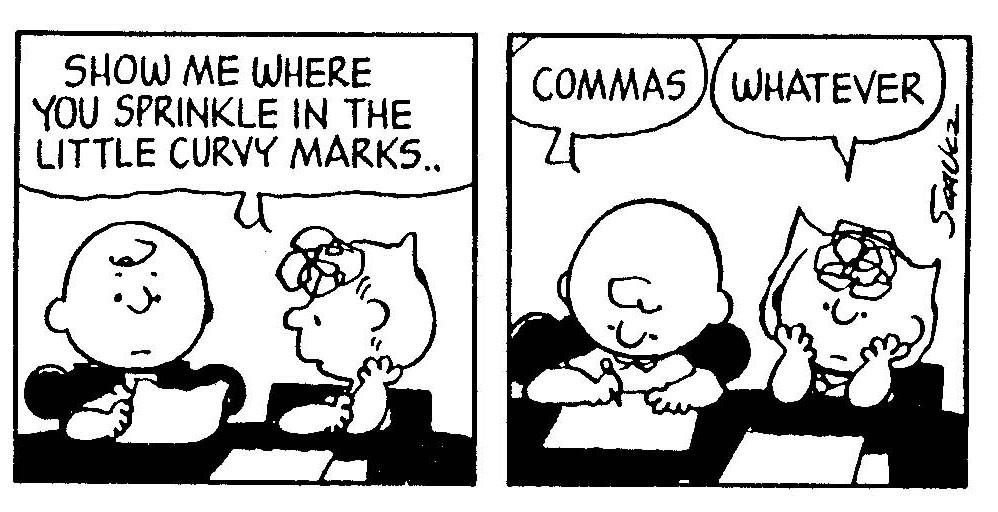
Commas and how they are used matter in real writing. Bear in mind, I?m talking about real writing, not texting, social media banter, or grocery lists. Earlier articles on the Em Dash, En Dash, and the Dash (or, hyphen) bear reading, but these lines of different length do not typically create minefields for those who use them improperly.
Commas, however, matter. And just how much they matter always depends on the material and the context in which they reside. Here?s a popular case in point.
Commas Matter
The Oakhurst Dairy in Portland, Maine, settled a court case in 2018 for $5 million with three truck drivers, all because of a missing comma. The drivers claimed they were owed a substantial amount of overtime pay, withheld for years, because of how a certain piece of Maine state legislation was written. Specifically, how the wording was separated by commas.
Maine state law declared that overtime wasn?t required for workers involved in ?the canning, processing, preserving, freezing, drying, marketing, storing, packing for shipment or distribution of: 1) agricultural produce; 2) meat and fish products; and 3) perishable foods?.
The drivers? attorney argued successfully before a US Court of Appeals that because there was no comma after ?shipment? and before ?or distribution? (what is traditionally known as the Oxford comma, now commonly eliminated in much writing), the drivers were owed back overtime pay from their employer. If the Oxford comma had been used in the wording of this law, it would have explicitly ruled out overtime pay for those who distribute perishable foods.
The absence of the Oxford comma in the labor law made two overtime-exempt tasks, packing and distributing food products, read like one activity. So any worker who distributed but didn?t pack any food products or vice versa sued the dairy company for their unsettled overtime pay. The workers won the suit.
The slip-up shows that the slightest misstep in punctuating a clause in a contract can have massive unintended consequences. In the grand scheme of things, commas might seem insignificant. But, as you can see, even one tiny error can cost you millions of dollars.
So, here are 7 important comma rules to follow to add clarity to your writing.
Use the Oxford Comma
The Oxford comma is likely one of the most controversial topics in the history of grammar. Even the Oxford Dictionary website labels it as an ?optional? comma in a series. It is the last comma used to separate items in a series, therefore it is also known as the ?serial? comma. The debate rages on concerning whether or not to use it and will continue, I?m sure. As for me, I say (in my humble but most accurate opinion) use it and make your writing clear. I?m sure the executives at Oakhurst Dairy would agree.
When asked by other writers what I suggest to help them write better, I always answer, ?Use the Oxford comma.? Now, of course, if you?re writing for a client and they specifically ask for their material to be left ambiguous and confusing without the Oxford comma, you must comply. I have to do so with some clients, albeit I grit my teeth while doing so.
Connect Two Complete Sentences with a Comma if there is a Coordinating Conjunction
It?s the old FANBOYS grammar and punctuation rule from sixth grade. FANBOYS is an acronym for the coordinating conjunctions to be used when joining complete sentences with a comma. For, And, Nor, But, Or, Yet, or So (notice the Oxford comma!).
A complete sentence has a subject and verb, expresses a complete thought, and can be its own sentence. For example, ?We found money in the gym,? and ?We turned it in to the office,? are both complete sentences.
But, if you place a comma between the two, like in the sentence, ?We found money in the gym, we turned it in to the office,? this is known as a comma splice, which can cost you at least 5 points on a sixth grade paper, and much more in prestige if you are a professional writer.
The correct manner of joining these two sentences is to insert a coordinating conjunction after the comma: ?We found money in the gym, so we turned it in to the office.?
Use a Comma to Link an Incomplete Sentence with a Complete Sentence
Incomplete sentences have a subject and verb but do not express a complete thought. For example, the sentence, ?Even though I told Kathy we gave the money back,? doesn?t express a complete thought and can?t stand alone. It is an incomplete sentence.
To repair this damage and create a complete and coherent thought, you must add a comma and a complete sentence to this clause. ?Even though I told Kathy we gave the money back, she did not believe me.? Here, ?She did not believe me? is a complete sentence, joined to the previous incomplete sentence with a comma.
It doesn?t matter whether the incomplete or complete sentence comes first. They can be used interchangeably as long as they are separated by a comma. ?She did not believe me, even though I told Kathy we gave the money back.?
Use a Comma between Two Coordinate Adjectives that Describe the Same Noun
Adjectives are considered to be coordinate when a sentence still makes sense after swapping the adjectives and placing the word ?and? between the two.
For example: ?I saw a crumpled, dirty bill as I left the gym? can also be written, ?I saw a crumpled and dirty bill as I left the gym.? Because the adjectives ?crumpled? and ?dirty? are interchangeable, and you can place an ?and? between them without muddling the sentence?s meaning, the adjectives are coordinate. You should place a comma between the two adjectives.
However, sentences with non-coordinating adjectives, like, ?I just ate some fragrant noodle soup,? don?t need a comma. In this example, ?noodle? is an adjunct noun, which means it acts like an adjective describing the noun ?soup?. But since ?noodle? is technically still a noun, and not an adjective, you don?t need to put a comma between ?fragrant? and ?noodle?.
You might want to read that again. Slowly.
Use Commas to Highlight Additional, Non-essential Information about a Noun
Sometimes writers get carried away and include extra information in a sentence. It isn?t exactly necessary to the overall meaning of the sentence, but it contributes something extra, so it is added. When this happens, the extra information is set apart in the sentence by commas.
For example: ?I use the Oxford comma, also known as the serial comma, in all my writing.? The words isolated by the commas give additional information about the subject noun, Oxford comma. But, they?re not essential for the sentence to make sense.
For example, I could write ?I use the Oxford comma in all my writing,? and the sentence still makes sense. In fact, I prefer shorter, to-the-point sentences. And here?s a slight twist: If any additional, non-essential information is included at the end of a sentence, place a comma before it, like, ?In all my writing, I use the Oxford comma, also known as the serial comma.?
Place a Comma before ?while? to Contrast Two Ideas
Using a comma before ?while? is the equivalent of using the extremely proper word ?whereas?. So, when contrasting two ideas, like, ?I like smaller, quick-turnover writing projects, while my mentor likes working on more creative projects,? put a comma before ?while?.
The absence of a comma before ?while? will describe two events that occur simultaneously. In the sentence, ?I like smaller, quick-turnover writing projects while my mentor likes working on more creative projects,? the impression is that we are both working on our projects the same time and that it is not a contrast of two preferences.
Place Commas Correctly in Quotes
In sentences containing quotes, the placement of a comma depends on whether the attribution is before or after the quote.
For example, when the attribution is before the quote, ?The boss said, ?I need more toner,?? you need to place the comma outside of the quotation marks.
When the attribution is after the quote, ??I need more toner,? said the boss,? you need to place the comma inside the quotation marks.
Comma usage can make or break your writing. As a professional writer and editor, most of the errors I see from other professional writers are in comma placement. The seven simple rules above will help clarify their usage in 99 percent of cases. In that elusive one percent, no one else probably knows either, so go with your best judgment.
Did you enjoy this treatment of commas in writing? Was it helpful? If so, consider recording some claps on this page. You may give up to 50.
Also, if you enjoy writing help like this, subscribe to my monthly newsletter at https://www.michaeldstover.com/subscribe.

